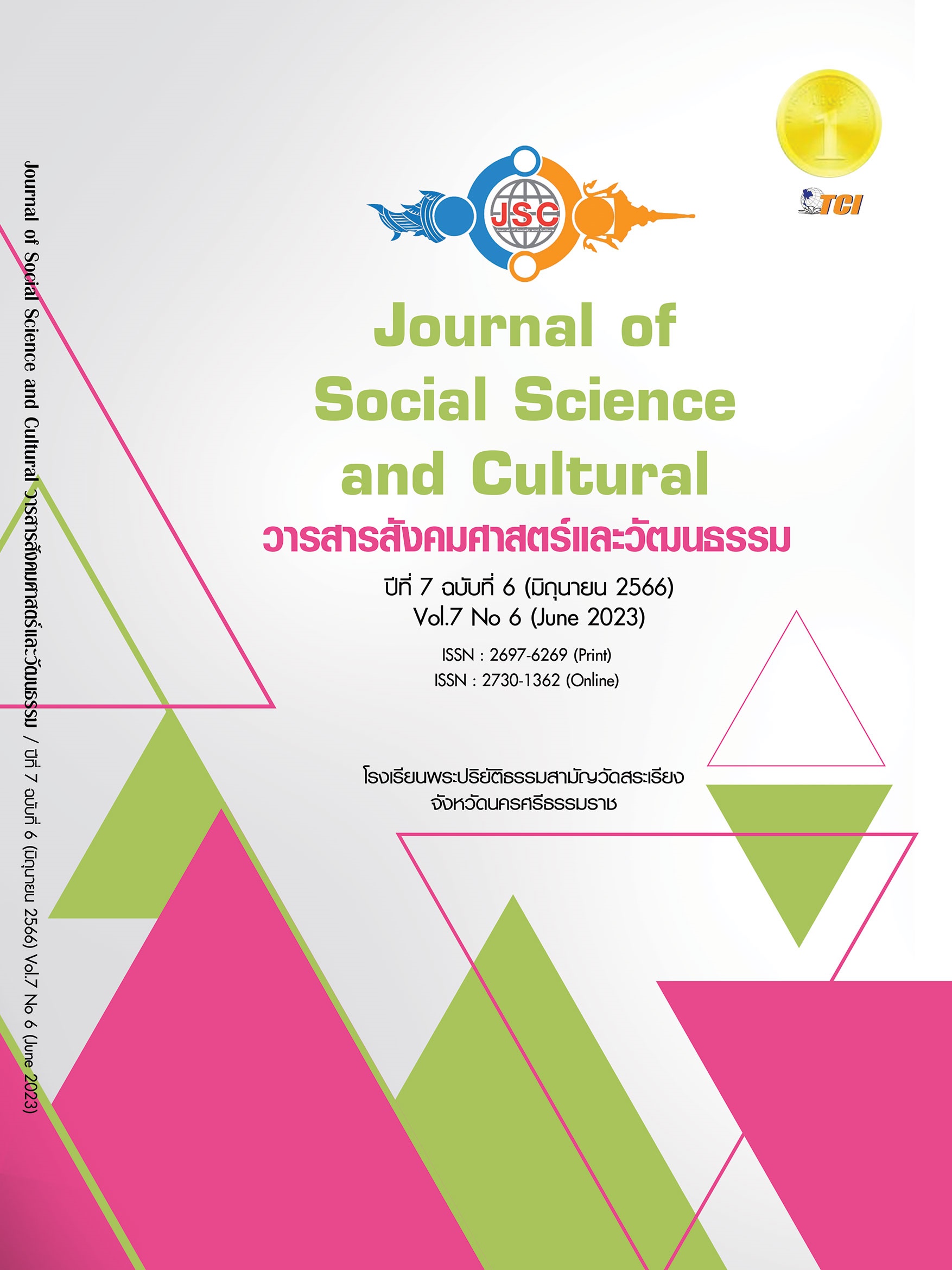THE DEVELOPMENT OF CREATIVE THINKING PROGRAMS TO CREATE INNOVATIONS IN TEACHING OF PRE-SERVICE INDUSTRIAL TEACHERS
Main Article Content
Abstract
This research is a quasi-experimental research. The objectives of this study were: to the development of creative thinking programs to create innovations in the teaching of pre-service industrial teachers and study the results of the programs developed. The sample group was 40 graduate students in 4th year industrial education. The research instrument used in the experiment were the development of creative thinking programs to create innovations in the teaching of pre-service industrial teachers, that developed on the 5E Inquiry-Based Instructional Model to be integrated together with the Design Thinking process and the Creativity Ability in Thinking Dimension, that was evaluated for the appropriateness of activities by experts. Data were collected before and after the experiment. The data were analyzed using mean, standard deviation, independent t-test and Paired sample t-test. The main research findings were: 1) The developed program is the most appropriate (M=4.72, S.D.=0.45). The assessment item with the highest average score was the activity presentation and activity steps (M =4.77, S.D.=0.43). 2) The experimental group had the post-test mean score (M= 95.17, S.D. = 14.69) higher than the pre-test (M= 59.26, S.D. = 5.6). And 3) after the experiment, the mean score of the experimental group (M= 95.17, S.D. = 14.69) was higher than the control group (M= 59.80, S.D. = 6.38).
Article Details
References
กระทรวงอุตสาหกรรม. (2559). กระทรวงอุตสาหกรรม ตอกย้ำโมเดล ประเทศไทย 4.0 ต่อยอด 5 กลุ่มเทคโนโลยี-อุตสาหกรรมเป้าหมาย สู่เวทีการค้าโลก. เรียกใช้เมื่อ 31 มีนาคม 2566 จาก http://www.oie.go.th
กองบริหารงานวิจัยและประกันคุณภาพการศึกษา. (2560). Thailand 4.0 โมเดลขับเคลื่อนประเทศไทยสู่ความมั่งคั่ง มั่นคง และยั่งยืน. กองบริหารงานวิจัยและประกันคุณภาพการศึกษา: กรุงเทพมหานคร.
ขจรพงษ์ ร่วมแก้ว. (2560). การพัฒนารูปแบบการเรียนรู้แบบเปิดตามแนวคิดคอนเน็คติวิสต์ซึม เพื่อส่งเสริมการคิดสร้างสรรค์สำหรับนักศึกษาระดับปริญญาตรี. ใน ดุษฎีนิพนธ์ปรัชญาดุษฎีบัณฑิต สาขาคอมพิวเตอร์ศึกษา. มหาวิทยาลัยราชภัฏมหาสารคาม.
ดุษฎี อินทรประเสริฐ. (2563). แบบแผนการวิจัยเชิงทดลองและการวิเคราะห์ทางสถิติ. (พิมพ์ครั้งที่ 2). กรุงเทพมหานคร: จรัลสนิทวงศ์การพิมพ์.
เบญจวรรณ ชีวานนท์. (2561). การพัฒนาการฝึกอบรมออนไลน์โดยใช้เทคนิคซินเนคติกส์เพื่อส่งเสริมความคิดสร้างสรรคในการออกแบบสื่อสิ่งพิมพ์เรื่องการผลิตสื่อสิ่งพิมพ์. ใน วิทยานิพนธ์ครุศาสตร์มหาบัณฑิต สาขาวิชาเทคโนโลยีการศึกษา. มหาวิทยาลัยศิลปากร.
ปกรณ์ รัตนทำ. (2561). การพัฒนากิจกรรมการเรียนรู้ผสมผสานตามรูปแบบซิปปาที่ส่งเสริมความคิดสร้างสรรค์สําหรับนักศึกษาปริญญาตรี. ใน วิทยานิพนธ์ครุศาสตร์มหาบัณฑิต สาขาวิชาคอมพิวเตอร์ศึกษา. มหาวิทยาลัยราชภัฏมหาสารคาม.
ปริญญา พวงจันทร์. (2556). การศึกษาความคิดสร้างสรรค์ในการทำโครงงาน เรื่อง ความสัมพันธ์ระหว่างราชอาณาจักรไทยกับสาธารณรัฐอินโดนีเซียของนักเรียนชั้นมัธยมศึกษาปีที่ 6 ด้วยการจัดการเรียนรู้แบบโครงงานสำหรับโรงเรียนคู่พัฒนาไทย-อินโดนีเซีย. ใน วิทยานิพนธ์ศึกษาศาสตร์มหาบัณฑิต สาขาวิชาการสอนและสังคมศึกษา. มหาวิทยาลัยศิลปากร.
พชรกมล เต็มใจ. (2554). การศึกษาผลสัมฤทธิ์ทางการเรียนสังคมศึกษาและความสามารถในการคิดสร้างสรรค์ของนักเรียนชั้นมัธยมศึกษาปีที่ 2 ด้วยการสอนแบบซิปปา โมเดล กับการสอนแบบ 4 MAT. ใน ปริญญานิพนธ์การศึกษามหาบัณฑิต สาขาวิชาการมัธยมศึกษา. มหาวิทยาลัยศรีนครินทรวิโรฒ.
รพีพล อินสุพรรณ และประสาท เนืองเฉลิม. (2563). การพัฒนาความคิดสร้างสรรค์ทางวิทยาศาสตร์และผลสัมฤทธิ์ทางการเรียนของนักเรียนชั้นมัธยมศึกษาปีที่4 โดยการจัดการเรียนรู้แบบสืบเสาะหาความรู้ตามแนวทางสะเต็มศึกษา. วารสารมหาวิทยาลัยราชภัฏยะลา, 15(2), 162-170.
รุจโรจน์ แก้วอุไร และศรัณยู หมื่นเดช. (2557). 8 ขั้นตอนการเรียนแบบโครงงานร่วมกับโซเชียลมีเดียเพื่อส่งเสริมทักษะในศตวรรษที่ 21. วารสารเทคโนโลยีการศึกษาและมีเดีย คอนเวอร์เจนซ์มหาวิทยาลัยทักษิณ, 1(1), 1-17.
วิชิต ทองประเสริฐ. (2561). การพัฒนาความคิดเชิงนวัตกรรมด้วยการบูรณาการการออกแบบโครงการและแผนผังความคิดสำหรับนักศึกษาทุนจากบริษัทกรุงไทยการไฟฟ้า จำกัด. สิกขาวารสารศึกษาศาสตร์, 5 (1), 7-15.
สมพร หลิมเจริญ. (2552). การพัฒนาหลักสูตรเสริมเพื่อส่งเสริมความคิดสร้างสรรค์สำหรับนักเรียนช่วงชั้นที่ 2. ใน ดุษฎีนิพนธ์การศึกษาดุษฎีบัณฑิต สาขาวิชาการวิจัยและพัฒนาหลักสูตร. มหาวิทยาลัยศรีนครินทรวิโรฒ.
สำนักงานคณะกรรมการพัฒนาการเศรษฐกิจและสังคมแห่งชาติ. (2560). นวัตกรรมนำสู่อนาคตประเทศไทย. เอกสารประกอบการประชุมประจำปี 2560 ของ สศช. เรื่อง “ขับเคลื่อนแผนฯ 12 สู่อนาคตประเทศไทย”. นนทบุรี: สำนักงานคณะกรรมการพัฒนาเศรษฐกิจและสังคมแห่งชาติ (สศช.).
สำนักงานเลขาธิการสภาการศึกษา. (2561). รายงานการศึกษาไทย ปี 2561. กรุงเทพมหานคร: พริกหวานกราฟฟิค.
สิทธิชัย แก้วเกื้อกูล. (2556). เอกสารโครงการประชุมวิชาการนานาชาติทางด้านนวัตกรรมการเรียนรู้ทางวิทยาศาสตร์และเทคโนโลยี 2014 คณะครุศาสตร์อุตสาหกรรมและเทคโนโลยี มหาวิทยาลัยพระจอมเกล้าธนบุรี วันที่ 22-24 มกราคม 2557 ณ โรงแรมเอ็มเพรส เชียงใหม่. กรุงเทพมหานคร : มหาวิทยาลัยพระจอมเกล้าธนบุรี.
สิทธิพงศ์ วัฒนานนท์สกุล. (2558). การพัฒนาทักษะการเรียนรู้โดยการเป็นผู้เรียนแบบรีเฟล็กทีฟ. วารสารพฤติกรรมศาสตร์, 7(1), 1-13.
อภิชาติ เนินพรหม. (2559). การพัฒนารูปแบบกระบวนการเรียนการสอนเพื่อเสริมสร้างความสามารถทางการคิดสร้างสรรคสำหรับผู้เรียนระดับประกาศนียบัตรวิชาชีพ ประเภทวิชาช่างอุตสาหกรรม. ใน ดุษฎีนิพนธ์ดุษฎีบัณฑิต สาขาวิชาวิจัยวัดผลและสถิติการศึกษา. มหาวิทยาลัยบูรพา.
Baybee, R., & Landes, N. M. (1990). Science for Life and Living: An Elementary School Science Program from Biological Sciences Improvement Study (BSCS). The American Biology Teacher, 52(2), 92-98.
Beghetto, R. A. . (2009). In search of the unexpected: Finding creativity in the micromoments of the classroom. Psychology of Aesthetics, Creativity,and the Arts, 3(1), 2–5.
Brown, T. (2009). Change by Design: How Design Thinking Transforms Organizations and Inspires Innovation. New York: Harper and Collins.
Cachia, R., & Ferrari, A. (2010). Creativity in Schools: A Survey of Teachers in Europe. Retrieved April 2, 2022, from http://ftp.jrc.es/EURdoc/JRC59232.pdf.
D. school. (2015). Design Thinking Bootcamp Bootleg. Retrieved April 1, 2022, from https://www.slideshare.net/UtaiSukviwatsirikul/design-thinking-bootcamp-bootleg
Johnson, B. (2019). 4 Ways to develop creativity in students. Retrieved May 10, 2022, from https://www.edutopia.org/article/4-ways-develop-creativity-student
Mullet, D. R., Willerson, A., Lamb, K. N., & Kettler, T. (2016). Examining teacher perceptions of creativity: A systematic review of the literature. Thinking Skills and Creativity, 21, 9–30.
Nielsen, D., & Thurber.S. (2016). The secret of the highly creative thinker: How to make connections others don’t. Amsterdam: BIS Publishers.
Plucker, J. A., Beghetto, R. A., & Dow, G. T. (2004). Why isn’t creativity more important to educational psychologists? Potentials, pitfalls, and future directions in creativity research. Educational Psychologist, 39(2), 83–96.
Renninger, K.A. (1992). Individual interest and development: implications for theory and practice. Retrieved May 4, 2023, from https://psycnet.apa.org/record/1992-97926-015
Siriporn Kruatong and Tussatrin Wannagatesiri. (2019). Science Student Teachers’ Designing Ability to Create Creativity STEM Lessons. In In Proceeding of ISET2019 The 7th International Conference for Science Educators and Teachers. Garden Cliff Resort & Spa Pattaya, Chonburi, Thailand.
Torrance, E. P. (1964). Encouraging creativity in the classroom. Iowa WM.C: Brown Company.
Wallach, M. A., & Kogan, N. (1965). Modes of thinking in young children. New York: Holtrien and Wintonston.
Xianhan Huang et al. (2019). What really counts? Investigating the effects of creative role identity and self-efficacy on teachers’ attitudes towards the implementation of teaching for creativity. Teaching and Teacher Education, 84(2019), 57-65.


